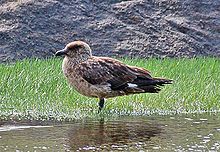Wildlife of Iceland

Thewildlife of Icelandis the wild plant and animal life found on the island ofIceland,located in the northAtlantic Oceanjust south of theArctic Circle.Theflora,fauna,andfungais limited by the geography and climate of the island. The habitats on the island include high mountains, lava fields, tundras, rivers, lakes and a coastal plain of varying width. There is a long coastline, much dissected byfjords,especially in the west, north and east, with many offshore islets.[1]
Background[edit]
Geography[edit]

Iceland is of volcanic origin with the landscape being influenced by water and wind erosion, abrasion and frost action. TheHighlandsform a plateau some 500 m (1,640 ft) above sea level, lying in the central and southeastern part of the island, and occupy about 40% of the landmass; they consist largely ofvolcanic desertsinterspersed with glaciers. Other parts of the country consist of mountains and hills surrounded by coastal lowlands, cut by steep-sided valleys and fiords. There are many small lakes and short, fast-flowing rivers. Only about 25% of the land has a complete cover of vegetation and two fifths of this is marshland. Another 69% is sparsely or very sparsely vegetated.[2]
Climate[edit]
The climate issubarctic.In general, the southern part of the island is warmer, wetter, and windier than the north. The coldest part of the country is the Central Highlands. The low-lying inland areas further north are the driest part but these areas of the country get the heaviest snowfalls in winter. The climate is rendered warmer than other places at similarlatitudesby theNorth Atlantic Currentand the coast normally remains free of ice.[3]
Flora and funga[edit]

There is a limited number of plant species in Iceland. Although the island was once fairly well forested at lower elevations, the arrival of settlers was followed by the felling of trees for construction and firewood and few trees now remain.[4]The settlers introduced livestock, and overgrazing, particularly bysheep,led to damage to the volcanic soils. Three quarters of the island is now affected bysoil erosion,with the remaining soil unable to support much vegetation.[5]The flora includes about 540 species of plant, with woody plants typically includingheather,bilberry,bearberry,crowberry,hairy birch,rowanandwillow.[6]Most of the trees are less than 2 m (7 ft) in height with a few taller trees in the river valleys of the north and east.[2]
Much of the northern part of the country is marshy or tundra, with the vegetation being predominantlymosses,lichensandsedges.Typical isIceland moss,alichenwhich grows abundantly forming mats on the tundras and mountain slopes and which can provide "famine food" in times of necessity.[7]Sedges and grasses dominate the vascular plants, with 53 species of the former and 47 of the latter. Ofdicotyledonousplants, the commonest family is theAsteraceae(daisy family), followed by theCaryophyllaceae(carnation family).[2]There are around 560 species ofbryophyte(mosses and liverworts), 550 species of lichen and 1,200 species of fungi, with both lichen and fungi being similar to those found in Scandinavia.[2]
Fauna[edit]

The only native land mammal on Iceland is theArctic fox.[8]Walruseswere native to Iceland, but disappeared after human settlement, likely as a result of hunting, climate change and/or volcanism.[9]Polar bearshave been known to occasionally visit the island, mostly drifting there fromGreenland.However, sightings of polar bears are rare, and those that are seen are usually killed for reasons of public safety.[10]
Animals that have been introduced include theAmerican mink,which escaped from fur farms and prospered, and thereindeer.A herd of reindeer in the southeast has died out but a larger herd in the northeast has a population of several thousand animals. Thewood mousehas also been introduced and inhabits the countryside, with thehouse mouse,thebrown ratand theblack ratbeing restricted to urban areas.[2]Batshave been increasingly recorded where they are thought to be either vagrants or artificially introduced.[11]

About 72 species of bird breed on Iceland. These include thegyrfalcon,thewhite-tailed eagle,themerlin,thesnowy owland theshort-eared owl.There are alsoducks,geese,waders,gullsand other sea birds, theArctic skuaand thegreat skua,with the Icelandic population of the latter representing almost half of the total world population. There are fewpasserines(perching birds), perhaps because of a lack of nesting opportunities or a dearth of insect food at some times of year.[2]
The rivers and lakes are home toAtlantic salmon,brown troutandArctic char,as well asEuropean eelandthree-spined stickleback,and there arerainbow troutwhich have escaped fromfish hatcheries.There are noamphibiansorreptileson Iceland.[2]
Around 270 species of marine fish occur in the waters around Iceland, with the most important commercial species beingcod,haddock,sea perch,plaice,herring,capelinandblue whiting.Theharbour sealand thegrey sealbreed on beaches and several species ofwhaleoccur in the waters, as well asdolphinsandharbour porpoises.[2]
References[edit]
- ^Philip's (1994).Atlas of the World.Reed International. p. 12.ISBN0-540-05831-9.
- ^abcdefgh"Biological Diversity in Iceland"(PDF).Convention on Biological Diversity. 2001.Retrieved5 November2018.
- ^Lamb H. (1995).Climate, History and the Modern World.Routledge.ISBN0415127351.
- ^"Wildlife".Iceland Worldwide.Iceland Whale Watching. 2000. Archived fromthe originalon 14 April 2010.Retrieved4 November2018.
- ^David R. Montgomery (2007).Dirt: The Erosion of Civilisations.University of California Press. pp. 224–225.
- ^Sandness, Roger K.; Gritzner, Charles F. (2009).Iceland.Infobase Publishing. pp. 27–29.ISBN978-1-4381-0509-3.
- ^Angier, Bradford (1974).Field Guide to Edible Wild Plants.Stackpole Books. p. 106.ISBN978-0-8117-2018-2.
- ^Evans, Andrew (2008).Iceland.Bradt Travel Guides. pp. 47–60.ISBN978-1-84162-215-6.
- ^Keighley, Xénia; Pálsson, Snæbjörn; Einarsson, Bjarni F; Petersen, Aevar; Fernández-Coll, Meritxell; Jordan, Peter; Tange Olsen, Morten; Malmquist, Hilmar J (2019-09-12). Nowick, Katja (ed.)."Disappearance of Icelandic walruses coincided with Norse settlement".Molecular Biology and Evolution.36(12): 2656–2667.doi:10.1093/molbev/msz196.ISSN0737-4038.PMC6878957.PMID31513267.
- ^"Killing polar bears in Iceland" only logical thing to do "".icelandmonitor.mbl.is.Retrieved15 December2020.
- ^Petersen, Aevar; Jensen, Jens-Kjeld; Jenkins, Paulina; Bloch, Dorete; Ingimarsson, Finnur (2014)."A Review of the Occurrence of Bats (Chiroptera) on Islands in the North East Atlantic and on North Sea Installations".Acta Chiropterologica.16:169–195.doi:10.3161/150811014X683381.hdl:10141/622681.S2CID86008251.
